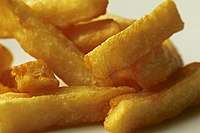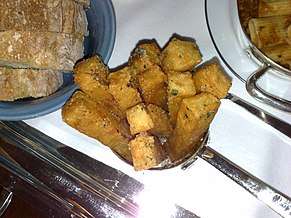Triple-cooked chips
Triple-cooked chips are a type of chips or deep-fried potato that were developed by English chef Heston Blumenthal. Blumenthal began work upon the recipe in 1993, and eventually developed the three-stage cooking process for their preparation. The preparation process involves the chips first being simmered and then cooled and drained of water using a sous-vide technique or by freezing, deep fried at 130 °C (266 °F) and again cooled, and finally deep fried again at 180 °C (356 °F). The result is what Blumenthal calls "chips with a glass-like crust and a soft, fluffy centre".[1]
 | |
| Course | Appetizer, side dish |
|---|---|
| Place of origin | England |
| Created by | Heston Blumenthal |
| Serving temperature | Hot |
| Main ingredients | Potato |
History
Blumenthal said he was "obsessed with the idea of the perfect chip",[2] and described how, from 1992 onwards, he worked on a method for making "chips with a glass-like crust and a soft, fluffy centre".[1]
He researched the starch content of different varieties of potato[2] and experimented with drying chips by microwaving, desiccating or even individually pinpricking them.[1] Eventually Blumenthal developed the three-stage cooking process generally known as triple-cooked chips, which he identifies as "the first recipe I could call my own".[1]
Preparation
Blumenthal's technique
Previously, the traditional practice for cooking chips was a two-stage process, in which chipped potatoes were fried in oil first at a relatively low temperature to soften them and then at a higher temperature to crisp up the outside. Heston's recipe involves simmering the potatoes first in water[3] for 20–30 minutes until they are almost falling apart and have developed many little cracks across the surface,[4] at which point they are drained and as much moisture as possible is expelled by placing them in either a freezer[5] or desiccator machine. This additional stage is designed to achieve three objectives. First, cooking the potatoes gently in water helps ensure they acquire a properly soft texture. Second, the cracks that develop in the chips provide places for oil to collect and harden during frying, making them crunchy.[6] Third, thoroughly drying out the chips drives off moisture that would otherwise keep the crust from becoming crisp. Blumenthal describes moisture as the "enemy" of crisp chips.[6]
The second of the three stages is frying the chips at 130 °C (266 °F)[5] for approximately 5 minutes, after which they are cooled once more in a freezer or sous-vide machine before the third and final stage: frying at 180 °C (356 °F)[5] for approximately 7 minutes until crunchy and golden. The second stage of low-temperature frying is as essential as the first, according to Heston, as it makes "any starch left in the surface cells dissolve and combine to create a rigid outer layer that can withstand the higher temperature of the final frying".[6] This second stage is time-consuming, he acknowledges, but must not be omitted. "A single frying at a high temperature leads to a thin crust that can easily be rendered soggy by whatever moisture remains in the chip’s interior."[6]
Other chefs, such as Joël Robuchon, had previously used such a method of cooking chips in simmering water before subjecting them to a two-stage frying.[7]
Variations

Variations include using a refrigerator to cool the chips in between cooking times and the use of different temperatures, such as 140 °C (284 °F) for the first cooking and 200 °C (392 °F) for the second.[4] Triple Cooked Chips cooked in duck fat is another variation. Various cultivars of potato are used, such as sebago,[4] Rooster and Maris Piper.[8]
Popularity
First served at The Fat Duck in 1995, triple-cooked chips have since become a standard feature in restaurants.
Reception
The Sunday Times described Blumenthal's dish as "arguably his most influential culinary innovation", and felt that it gave the chip "a whole new lease of life".[8]
See also
- List of deep fried foods
- List of potato dishes
- List of twice-baked foods
- Pommes soufflées – a variety of French fried potato. Slices of potato are fried twice, once at 150 °C (300 °F) and then again after cooling, at 190 °C (375 °F).[9]
References
- Blumenthal, The Big Fat Duck Cookbook
- Blumenthal, In Search of Perfection
- Fort, Matthew (29 April 2011). "Food for Fort: The quest for the perfect chip". The Guardian. Retrieved 17 June 2014.
- Moran, Matt (20 November 2011). "Matt Moran makes Heston Blumenthal's triple-cooked chips". The Daily Telegraph. Retrieved 17 June 2014.
- Stewart, Victoria (29 May 2013). "Hot chips: the 50 best chips in London". London Evening Standard. Retrieved 17 June 2014.
- Blumenthal, Heston Blumenthal at Home
- Jeffrey Steingarten, The Man Who Ate Everything (New York: Vintage Books, 1998), 409
- Heston Blumenthal (2013-11-17). "Triple-cooked chips, by Heston Blumenthal". The Sunday Times. Retrieved 2014-06-17.
- "Pommes soufflées". Saveur-Bonner Corporation. 2009. Retrieved 2009-06-20.
Bibliography
- Blumenthal, Heston (2006). In Search of Perfection. Bloomsbury Publishing. ISBN 0747584095
- Blumenthal, Heston (2008). The Big Fat Duck Cookbook. Bloomsbury Publishing Plc. ISBN 0747583692
- Blumenthal, Heston (2011). Heston Blumenthal at Home. Bloomsbury. ISBN 1408804409
Further reading
- Sanghvi, Vir (17 June 2011). "French fries: Holy Grail of cooking". Hindustan Times. Retrieved 17 June 2014.
- "Triple Cooked Chips Recipe". Channel 4. Retrieved 17 June 2014.
External links
| Wikimedia Commons has media related to Triple-cooked chips. |
- Triple-Cooked Chips. Epicurious.
- Heston's Triple Cooked Chips. Great British Chefs.
- Fillet Steak with Triple Cooked Chips and Bearnaise Sauce. Lifestyle Food.